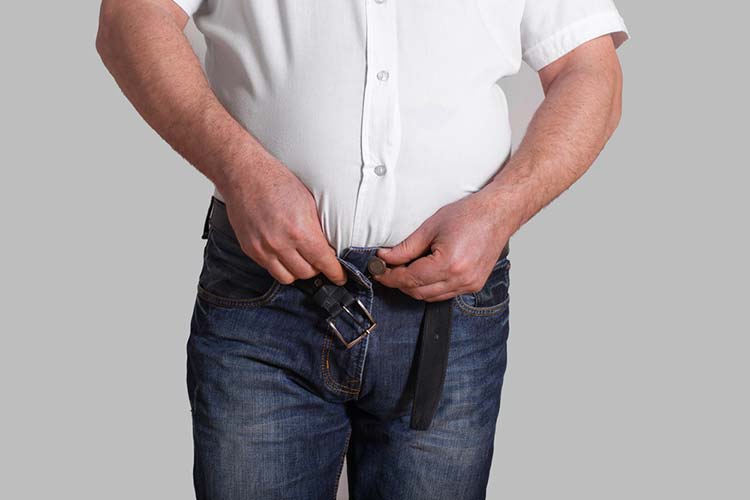Paunches come in different belly sizes and even shapes. Look around you… Some are round as an O and may even seem as if a football is loaded inside the Tee/shirt.
But it is no laughing matter; belly fat can increase the risk for a variety of diseases.
Men have a seemingly biological leaning towards paunches as they age, especially as they touch 40s. One of the reasons for this is the reduction in testosterone, which leads the excess calories to get stored in the viscera. And, with age, there is also the natural loss of muscle mass, which is again reflected in the weight gained, as it causes a decline in metabolism.

Unlike women who tend to gain weight in the hips and thighs, especially during child bearing years, men, on an average, gain weight around their waist.
So, where do YOU stand in the belly fat zone?
Are you one of those lucky ones who has never been bothered by fat, in the belly or anywhere?
Perhaps, you are not sure if your belly can be classified as fat?
Here is a simple way to check it out: stand up and place a measuring tape around your stomach, just above the hipbone; hold it snugly around the stomach without pinching the flesh; relax and measure the tape. If the figure is more than 40 inches, you certainly have an unhealthy concentration of fat in your belly. Another way to go about it is to measure your waist-to-hip ratio. Typically the ratio will be 0.90 in younger men, which could increase to 0.98 in older men.


But whether your overall weight has any bearing on your health or not, belly fat does increase your risk for a variety of non-communicable diseases like cardiovascular disease, insulin resistance and type 2 diabetes, colorectal cancer, sleep apnoea and high blood pressure.
While age is a perpetrator, belly fat is also largely determined by how the body strikes a balance between the calories you eat and the energy you burn. Weight gain and belly fat happens if you eat too much and exercise too little. Genetics also plays a role in this belly game, as it directly contributes to your chances of being overweight and also has a say in where the fat is stored.
Ways and means to trim the belly
The obvious way to trim the belly fat is to lose weight and get on an exercise regimen. However, exercise has to be specific, as toning with crunches and other abdominal exercises cannot simply rid you off your belly weight. Here are some ways to get you started:
Healthy diet: A healthy diet for your weight loss plan is one that is focused on consuming fruits, vegetables and whole grains, with lean sources of protein. Reduce the intake of saturated fat found in meat and high-fat dairy products; limit processed meats. Complement this diet by eating moderate portions and cutting down on all sugary beverages.
Exercise: Experts recommend moderate aerobic activity for at least 150 minutes a week or vigorous activity for 75 minutes a week for healthy adults. But when the goal is to lose weight and not just ensure fitness, more exercise is called for. Remember there is no magical spot reduction remedy. You need to find ways to get stronger, as strength training builds muscle mass; it prevents muscle loss and helps you meet your fat loss goal. Gym instructors also recommend the Squat and Deadlift to build strength.


Lifestyle changes: The most important lifestyle change you need to incorporate is stop smoking as it present numerous health risks. Eat foods that are right for your body – a little research or consultation with a trained nutritionist will help. Follow that up by getting adequate sleep, as too little or too much can easily lead to more visceral fat. A study has, in fact, found that consistently getting less than six hours or more than nine hours sleep per night led to greater abdominal fat in people younger than 40.
Higher motivation: If there is anything that will help you reach your goal of weight loss easily, it is your motivation. Seek motivation by measuring the body fat and your waist, every two weeks. Keep a track of your progress and get motivated with every little milestone that you achieve. Remember to keep stress away, as it can play a punishing role in turning the belly hard and fat.
And, after all is said and done, losing that fat in your belly takes effort and patience. Don’t lose hope if it refuses to budge in the initial phase.
